Introduction
 Top Top
Bacterial Stalk RotErwinia carotovora,Erwinia chrysanthemi
Occurrence
- This disease occurs in many states including Telangana where
high temperatures coupled with high humidity develop during
the pre-flowering stage of the crop.
Disease cycle
- Borer insects play a significant role in initiation of the disease. The organism is soil borne and makes its entry through wounds and injuries on the host surface.
- The organism survives saprophytically on debris of infected materials and serves primary inoculum in the next season.
Epidimeology
- High humidity especially overhead irrigation and waterloging, coupled with high temperature (30°C and above), are conducive for disease development.
Symptoms

Rotting of Internodes |
- The basal internodes develop soft rot and give a water soaked appearance. A mild sweet fermenting odour accompanies such rotting.
- Leaves some time show signs of wilting or water loss and affected plants within a few days of infection lodge or topple down.
- Ears and shank may also show rot. They fail to develop further and the ears hang down simply from the plant.
|
Control measures
- Use of disease resistance varieties, While no absolute resistance has been identified so far, Hybrids Ganga Safed-2, DHM 103, show significantly less disease incidence than other hybrids.
- Avoid waterlogging and poor drainage.
 Top Top
Black Bundle Disease And Late Wilt: Cephalosporium maydis, Caphalosporium acremonium
Epidemiology
- Both the pathogens survive in soil, plant debris and seed. The disease is favoured by post flowering water stress.
Symptoms
- The disease kills the plant prematurely after flowering. Infected plants do not show symptoms until they reach the tasseling.
 |
 |
- Wilting generally starts from the top leaves, Leaves become dull green, eventually loose colour and become dry.
- In advance stages the stalk loses its healthy green colour, lower portions become dry, shrunken with or without wrinklings, hardens and turn purple to dark brown which in more prominent on lower internodes.
|

Brown vascularbundles |
- When split open diseased stalks, show brown vascular bundles starting in the underground portion of the roots.
- Diseased plants produce only ears with undeveloped shrunken kernels.
- In severe cases affected plants remain abortive causing 100 per cent loss.
- Cephalosporium maydis is primarily soil borne and may infect young maize plants more readily than other plants through roots or mesocotyl. In case of C. acremonium only vascular burdles get blackened.
|
Control measures
- Use of resistant varieties like DHM 103, Ganga Safed 2. .
- Crop sanitation, crop rotations. .
- Avoiding water stress at flowering. .
- Seed treatment with Thiram or Captan 3g/kg seed.
 Top Top
Charcoal-Rot : Macrophamina phaseolina
Occurrence
- Charcoal rot is prevalent in comparatively drier maize growing
areas, particularly Andhra Pradesh, Telangana, West Bengal,
Bihar, Uttar Pradesh and Delhi.
Epidimeology
- The disease development is maximum during grain filling stage and is favoured by warm temperature (30°-40° C) and low soil moisture.
- Charcoal rot is found to be prevalent particularly in rabi season when summer temperatures during post flowering period becomes comparatively high (35°- 45° C).
Disease cycle
- The pathogen also attack many other hosts, which helps in its perpetuation. Since the fungus is a facultative parasite it is capable of living saprophytically on dead organic tissues, particularly many of its natural hosts producing sclerotial bodies.
- The fungus over winter as a sclerotia in the soil and infects the host at susceptible crop stage through roots and proceed towards stem.
Symptoms

|
- The characteristic symptoms of the disease become apparent as the plants approach maturity. The disease generally appears early after flowering.
- Plants affected by M. phaseolina show evidence of pre-mature ripening. The out sides of lower internodes become straw coloured. The pith becomes badly disintegrated.
|

Black sclerotia |
- The infected stalks may split longitudinally into a mass of fibres.
- A distinguishing character of the disease is the presence of the small black sclerotia in the pith of the affected stalks. Roots are also invaded and show black sclerotia in the disorganised tissue.
|
Control measures
- Regular irrigations particularly during flowering time should be provided.
- Use resistant varieties like DHM 103, Ganga Safed - 2 and avoid sowing of suceptable varieties like DHM 105.
- Seed treatment with Carbendazim or Thiram 3g/kg seed is effective.
- Field sanitation, crop rotation should be followed.
 Top Top
Common Rust:Puccinia sorghi
Occurrence
- This disease is prevalent in cooler parts of the country but its destructiveness is more apparent in rabi maize in Bihar.
- It is very common in Himalayan region during Kharif season and in South India during rabi season.
- Considerable yield losses were observed in coastal districts in late plantings during rabi.
Epidemiology
- Cold temperature (16°-23° C) and higher relative humidity favor the rust development and spread.
Symptoms

Brown pustules |
- Circular to elongate golden brown or cinnamon brown, powdery, erumpent pustules appear on both leaf surfaces.
|
 |
- As the crop matures brownish black pustules containing dark thick walled two celled teliospores develop. In severe cases infection spreads to sheaths and other plant parts.
|
Control measures
- Plant hybrids like Deccan, Ganga-5, Deccan Hybrid Makka-103 and DHM - 1 which are resistant to this disease to minimise the disease intensity
- Spray Mancozeb 2.5g/lit or Dithane M-45 spray can be taken (0.4%) as soon as first symptoms are observed and it can be repeated at 10 days interval till flowering.
 Top Top
Downy Mildews
- Downy mildews are an exciting group of fungi which attacks many economically important crop plants.
- Ten downy mildew diseases are known on maize caused by two genera viz., Peronosclerospora and Sclerophthera.
- Out of these, Sorghum Downy Mildew and Brown stripe downy mildew are common in our country.
Sorghum downy mildew : Perenosclerospora sorghi.
- Greatest loss results from systemic infection. This most often results in death or barrenness.
- Local infection probably does not cause economic loss in maize.
- Losses have been reported to be as high as 40-60%. Significant loss is usually localized to late planted areas.
Symptoms

Malformation of Tassel |
- Early maize crops escape infection because by the time conidia are produced they develop resistance on the collateral host susceptibility occurs only upto about 15 days of age.
-
In susceptible seedling plants, less than 4 weeks after seedling infection becomes systemic in all growth, subsequent to downward growth of mycelium and colonization of shoot apex (growing point). All Peronosclerospora spp. induce both local and systemic infection.
- Malformation of tassels in infected plants.
|

Chlorosis |

White stripes |

Downy Fungal Growth |
- Chlorosis, white stripes, stunting with downy fungal growth on both leaf surfaces are the characteristic symptoms.
Life cycle
- The disease has been known to occur through a collateral host Heteropogen centortus on which the fungus perpetuates into the host.
- The role of Heteropogen as a collateral host was proved by the cross inoculation tests and occurrence of the disease in the fields adjacent till both conidial and oospores, formed on the collateral host, serve as the primary incolum.
- The breakdown of tissue causes shredding. The oospores either fall to the soil or wind blown, often within host tissue. They can remain viable in the soil for 5-10 years.
- Conidia are formed at night in large numbers. The optimum temperature for production is 20-23 degree Celcious.
Brown stripe Downy mildew : Sclerophthora rayssiae.
Occurrence
- In India, it has been most severe in Uttar Pradesh, Himachal Pradesh, Southern Rajastan, the Punjab and Hilly parts of West Bengal, especially in areas, which receive 100-200 cm of precipitation.
- A yield loss of 63% was recorded in the Tarai region of Uttar Pradesh.
Disease cycle
- The Oospores present in soil serve as source of primary infection.
- They form sporangia and the infection appears in the form of minute flecks (Characteristics of zoosporic infections) on the leaves, which grow to form the brown streaks.
- Secondary infection is about by sporangia formed on the lower surface of infected leaves.
Symptoms

Chlorotic stripes |
- Disease symptoms have been observed only on leaves. They are vein limited.
- Wilting generally starts from the top leaves, Leaves become dull green, eventually loose colour and become dry.
- Chlorotic stripes, 3-7 mm wide will develop and they further extend in parallel fashion and may in severe cases cover the entire leaf lamina.
- Severe infection also incites blotching. The stripes in advanced stage become necrotic with purple or reddish colour and present a burnt appearance.
|
Crazy top downy mildew: Sclerophthora macrospora
Symptoms
- Disease symptoms first appear as rolling and twisting of upper leaves before mallformation of tassel.
- The important symptoms of the disease is the partial or complete malformation of the tassel which continues until the tassel resembles a maas of narrow, twisted, leafy structures.

Stunting |

chlorosis |
- Affected plants show excessive tillering, stunted with chlorotic stripes on leaves.
Sugarcane downey mildew:Peronosclerospora sacchari

White streaks |
-
Characterized by local lesions and systemic infection. Initial leasions are small, round, chlorotic spots on the leaves.
- Systemic symptoms appear as pale yellow to white stripes or streaks at the base of the 3rd to 6th oldest leaves.
- Several streaks may develop on leaf and may extend on the entire leaf.
- Downy growth is seen on both the leaf surfaces. Plants may be distorted with small, poorly filled ears with mis-shapen tassels.
|
Epidemiology
- High relative humidity with a temperature of 20°-25° C favours the disease development. Zinc deficiency predisposes plants to infection.
Control measures for downy mildew diseases
- The eradication of collateral and wild hosts near maize field and rouging infected maize plants has been recommended.
- Destruction of plant debris by deep ploughing and other methods.
- Seed treatment with Metalaxyl at 4 g/kg and foliar spray of Mancozeb 2.5 g/l or Metalaxyl MZ at 2g/l is recommended.
- Use of resistant varieties like DMR 1, DMR 5 and Ganga 11.
 Top Top
Head Smut: Sphacelotheca reiliana
Occurrence
- Reported from Tamilnadu, Telangana, Andhra Pradesh, Karnataka,
Madhya Pradesh, Uttar Pradesh and Punjab.
Epidemology
- The fungus survives in the soil. Soil temparature of 21-28° C with moderate to low soil moisture (15-25%) are optimal for seedling infection
Symptoms
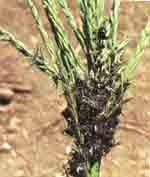
Malformed Tassel |
- Head smut appears when ears and tassels are formed.
- Floral structures may be partially or completely converted to sori containing masses of brownish black teliospores.
- Tassel infection may be confined to individual spikelets. In such cases floral bracts grow out in to leafy structures, some times in to small shoots.
|
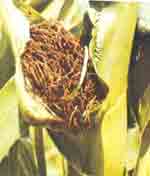
Aborted leafybud |
- Ears infected plants may be smutted or aborted with leafy buds replacing normal ears.
- Such plants donot produce pollen. Infected plants are dwarf with increased tillering.
|
Control measures
- Field sanitation, crop rotations.
- Seed treatment with Thiram or Captan 3g/kg seed.
 Top Top
Maydis Leaf Blight: Helminthosporium maydis
Occurrence
- The disease is prevalent in Northern states. It is not a
major disease in Andhra Pradesh and Telangana.
Symptoms

Lesions on leaf |
- Leaves show greyish, tan, parallel straight sided or diamond shaped 1-4 cm long, lesions with buff or brown borders or with prominent colour banding or irregular zonation.
|
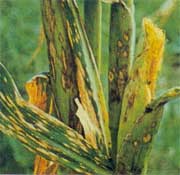
Symptoms on leafsheath |
- Symptoms may be confined to leaves or may develop on sheaths, stalks, husks, ears and cobs.
- The lesions longitudinaly elongated typically limited to a single inter vascular region, often coalescing to form more extensive dead portions.
|
Control measures
- Growing resistant hybrids DHM 103, and DHM 1.
- Use protective fungicides of Carbamate or Mancozeb group.
 Top Top
Maize Mosaic
Symptoms
 |
- Symptoms appear as Chlorotic spots, short lines and broken to nearly continuous Chlorotic stripes covering entire leaf blade.
- Chlorotic stripes and spots can also develop leaf sheaths, stalks and husks. Moderate to severe rosetting of new growth is observed.
|

Chlorotic stripes |
- Size of stalk, leaf blades and tassel tend to be normal in late infection.
- Maize mosaic virus is transmitted by Leaf hopper Peregrinus maidis.
|
Control
- Destroy the alternate hosts.
- Spray systemic insecticides like Monocrotophos 1.5 ml/l or Dimethoate 2 ml/l for the control of vector.
 Top Top
Maize Dwarf Mosaic: Maize Dwarf Mosaic Virus (MDMV)
Symptoms
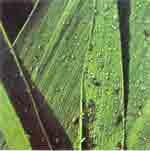
|
- Symptoms first appear on the youngest leaves as irregular, light and dark-green mottle or mosaic.
- Later they develop into narrow sreaks along veins that appear as dark green islands on a clorotic back ground.
|
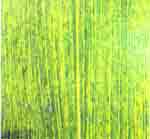
Dark green streaks |
- Plants are stunted, with excessive tillering multiple ear shoots and poor seed set.
- The virus is transmitted by AphidsRhopolosiphum maidis Myzus persicae,Schizaphis graminicum.
|
Control
- Destruction of Johnson grass or other wintering reservoir hosts
- Spray systemic insecticides like Monocrotophos 1.5 ml or Dimethoate 2 ml/l for the control of vector.
 Top Top
Pythium Stalk Rot: Pythium aphanidermatum
Symptoms
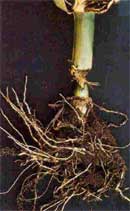
Affected internodes |
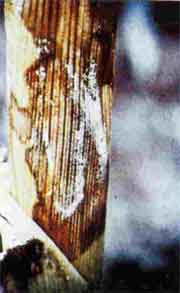
Brown elliptic lesions |
- The lower internodes near the ground level show brown elliptic lesions. In the affected part of the internode the pith is destroyed but not the fibre vascular bundles.
- The stalk as a result becomes weak and breaks leading to lodging of the plant. Such lodged plants continue to remain green for some days.
Control
- Avoid water logging and close planting.
- Apply Captan (150 gms/100 litres of water) as a soil drench, when the crop is 5-7 week old.
- Hybrids Ganga Safed-2 , Hi-starch and DMH-103 should be preferred for avoiding the high incidence of the disease.
 Top Top
Seed Rots And Seedling Disease
- These are incited by species of Fusarium, Rhizoctonia, Aspergillus, Pythium, Cephalosporium etc.
Occurrence
- These occur mainly in areas where the soil temperature are low (cooler areas in the Himalayas and in the hill regions of Southern Rajasthan).
Epidemiology
- The problem becomes severe with the use of old seeds stored under high temperature and humidity and sown during winter.
Symptoms
- Infected seeds when sown, produce thin stands of the crop with gaps, pre-emergence seed rot, post emergence damping off, brown sunken lesions on mesocotyl, collar rot, wilting, toppling of collapsed of seedlings.
Control Measures
- Mechanical sieving or winnowing of seed lots meant for sowing eliminates lightweight, chaffy injured or infected seeds.
- Seed should be treated with the fungicide Thiram (25%) or Captan 2 to 2.5 gm/kg of seed by vigorously shaking in a closed metal drum or earthen vessel before sowing.
- Use certified seed.
- Avoid planting in cold, wet or water logged soil.
 Top Top
Smut : Ustilago maydis
Disease cycle
- The sporidia, produced by germination of teleutospores which infect the soil, cause shoot infection.
- Dikaryotization though not essential for growth in host tissue is however, essential for gall formation.
- The successive generations of teleutospores cause secondary local infections.
Epidemiology
- Disease development is favoured by dry conditions and temparatures between 26-34° C. High nitrogen and injuries increase the potential for smut infection.
Symptoms

Galls on stalks
and leaves
|

|
- Ground parts are suceptable, particularly young, actively growing meristematic tissues.
- Galls are formed on the ears, axillary buds, tassels, stalks and some times on the leaves ears, axillary buds, tassels, stalks and some times on the leaves causes smut disease in ears and tassels by which they are partially transformed to galls.
|
- Galls are first covered with a glistening, greenish to silvery white tissue. The interior of these galls darkens and turns into masses of powdery, dark olive brown to black spores, except for galls on leaves.
- Plants with galls on lower stalks may be barren and produce small ears. Galls on young seedlings may result in stunting or death of the plants.
Control
- Crop rotation
- Avoiding mechanical injury to plants during cultivation.
- Avoid applying of higher doses of nitrogen.
- Uproot the smut-affected plants.
- Seed treatment with Thiram or Captan 3g/kg seed.
 Top Top
Turcicum Leaf Blight: Helminthosporium turcicum
- This disease has a world wide distribution. In India the disease is prevalent in the Himalayan region, Peninsular India and the State of Bihar.
- The hot spots being Mandya in Karnataka, Kolhapur in Maharashtra, Karimnagar in Andhra Pradesh and Dholi in Bihar.
Occurrence
- This disease is prevalent in the areas where maize is planted in the high lands (more than 1000m altitude), where temperate conditions prevail and in winter plantings in the plain as the cool/moderate conditions favour disease development.
Epidemiology
- The occurrence and damage is severe in areas with heave dew and rainfall with temperature of 18 to 27° C.
Symptoms
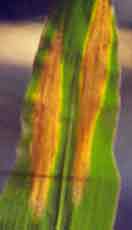
Long lesions on leaf |
- Turcicum leaf blight (Northern corn leaf blight) on maize is characterized by long elliptical, grayish green or tan lesions on the leaves measuring 2.5 to 25 cm in length and 4 cm in width.
- Lesions first appear on the lower leaves and increase in size and number until very little living leaf tissue is left. Spores produced on the under surface are arranged in concentric zones resembling a target like pattern when observed against light.
- Crop debris is the usual source of primary inoculum. Once the infection takes place it spreads through wind currents.
|
Control measures
- Use of resistance varieties like CM 104, CM 118, CM 121 and DHM 1 is the most effective and economical method of reducing the losses.
- Chemical control as general practice is not recommended to the farmers. However the protection of precious material either experimental or seed production, spraying with Mancozeb @ 0.25 to 0.4% when made at 8-10 days interval is effective.
 Top Top
|

















